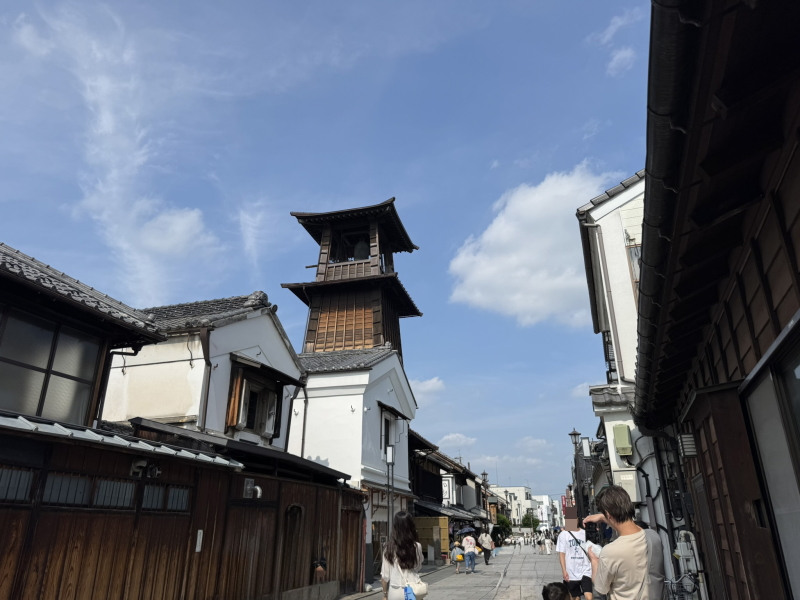
Kawagoe is far more than a simple tourist destination. It is a living city where layers of time—past, present, and future—intertwine and coexist. Known affectionately as Little Edo for its preserved Edo-period architecture and atmosphere, Kawagoe’s origins trace back to the medieval era as a castle town surrounding Kawagoe Castle.
Over the centuries, the city evolved from a regional military stronghold into a bustling merchant hub during the Edo period, and later embraced modernization during the Meiji and Taisho eras. Even today, its historical urban layout, traditional earthen-walled storehouses (kurazukuri), and enduring place names serve as “geographical memories,” preserving the essence of its cultural identity.
Kawagoe’s enduring appeal lies in its rare ability to retain the urban structure of its early origins while continuing to grow and adapt to modern life. In this sense, it stands as a remarkable example of a city that lives in harmony with its own history.
Modern Challenges and the Quest for Balance
In the modern age, Kawagoe welcomes over seven million visitors annually. While tourism has become a powerful economic driver, it has also introduced new urban challenges such as redevelopment, environmental sustainability, and the preservation of cultural heritage.
For example, large-scale redevelopment projects around Kawagoe Station have dramatically improved convenience and accessibility. New pedestrian decks, shopping complexes, and residential towers have transformed the city’s skyline. Yet, these developments also raise questions about how to maintain harmony between modern architecture and the historic landscapes of Kurazukuri Street and other preserved districts.
To address these concerns, local authorities have implemented measures such as undergrounding utility cables, enforcing height restrictions, and encouraging the use of traditional materials in new construction. These initiatives demonstrate that the city aims not only to preserve its appearance but also to protect its deeper sense of cultural continuity and beauty.
At the same time, Kawagoe must balance the rhythms of local life with the needs of visitors. Managing the flow of tourists, reducing congestion, and protecting residents’ daily comfort are all part of the ongoing challenge. The future of Kawagoe depends on finding a coexistence model—a way for tourism, community life, and urban development to flourish together.
A Historical-Geographical Vision for the Future
From the perspective of historical geography, Kawagoe offers a fascinating study in how a city can reuse and reinterpret its inherited urban structure. Districts that once served as merchant quarters, temple towns, and samurai residences have evolved into modern zones of commerce, culture, and hospitality. This dynamic adaptation represents not restoration, but creative continuity—a living dialogue between tradition and innovation.
Old merchant houses are being reborn as cafés, boutique inns, and craft studios, while traditional industries such as soy sauce brewing and sweet-making are reimagined for contemporary audiences. This process of “reconstruction through memory” is transforming Kawagoe from a preserved tourist site into a city that actively generates new culture and value.
Thus, Kawagoe’s evolution is not about freezing history in time but about weaving it into the fabric of modern life—a sustainable regeneration that honors both heritage and progress.
Tourism and the Living City: Toward Sustainable Urban Harmony
Tourism is not merely about showcasing a city’s beauty—it is also about passing its memory and spirit to the next generation. When visitors perceive not only the physical scenery but also the invisible flow of time and the lives of the people who inhabit the city, tourism becomes an act of empathy rather than consumption.
Kawagoe excels in this balance. Its charm lies in the seamless interaction between residents’ daily lives and visitors’ experiences. Markets filled with local produce, festivals organized by neighborhood associations, and traditional craft workshops create moments of genuine cultural exchange.
For Kawagoe to thrive as a sustainable destination, it must shift from quantitative expansion to qualitative enrichment. The goal is not simply to attract more tourists, but to offer deeper, more memorable experiences that encourage longer stays and stronger emotional connections. In doing so, Kawagoe can continue to grow as a model city where culture, economy, and community coexist in harmony.
A Living Urban Heritage for the Future
Kawagoe is not a museum of the past—it is a living urban heritage that connects history to the present and guides it into the future. Its townscape tells a story of resilience, adaptation, and creativity. Each street, temple, and warehouse carries memories that continue to shape the city’s identity today.
This website aims to inspire visitors to look beyond Kawagoe as a simple sightseeing destination and instead appreciate it as a living city—one that continues to evolve while preserving the heart of its history.
By walking through its streets with an awareness of time’s layers—the past that built them, the people who maintain them, and the future they point toward—visitors can experience Kawagoe as more than just a beautiful place.
They can experience it as a city that connects yesterday, today, and tomorrow—a city that lives and breathes its own timeless story.
- Seven sightseeing points for Koedo Kawagoe
- Point 1|The Bell of Time and the Warehouse Streets: Historical Background
- Point 2|Remains of Kawagoe Castle and Castle Town: The Relationship between Control and Spatial Structure
- Point 3|Revitalizing Kashiya Yokocho: Integrating tourism with local culture
- Point 4|Memories of Kawagoe’s Waterfront and Boat Transport: The Shingashi River and Urban Development
- Point 5|Kawagoe Festival: An urban celebration where space and time intersect
- Point 6|The dilemma of modern redevelopment and landscape preservation: conflict between urban transformation and historical landscape
- Point 7|A stroll through Kawagoe from a local perspective: Walking the intersection of civic life and tourism

